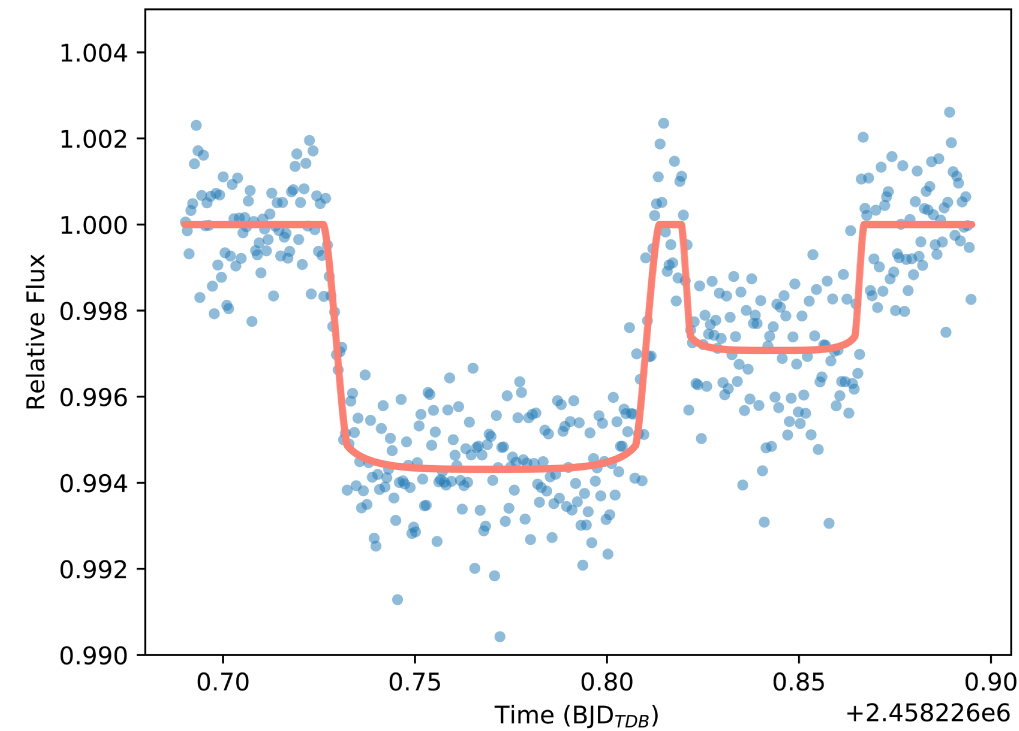Here is an overview of some of my past and current research.
Occurrence rates of terrestrial planets orbiting mid-to-late M dwarfs
 Figure: Estimated cumulative occurrence rates of planets per star as a function of planet size and stellar insolation.
Figure: Estimated cumulative occurrence rates of planets per star as a function of planet size and stellar insolation.
I have undertaken a comprehensive analysis of the volume-complete all-sky sample of nearby (within 15 pc) mid-to-late M dwarfs (masses from 0.1 to 0.3 MSun). This sample is described in greater detail by Winters et al. (2021). Focusing on the 363 stars (out of 512) observed by TESS within Observation Sectors 1-42, I combined a planet detection, injection, and recovery analysis to estimate the occurrence rate of planets orbiting close to their host stars (orbital periods up to 7 days, or stellar insolation values above 4 Earths). This study yielded a cumulative occurrence rate that is consistent with previous studies of more massive M dwarfs (e.g. Dressing & Charbonneau 2015). I also found that small terrestrial planets (consistent with a pure rock composition) are significantly overrepresented compared to larger planets such as enveloped terrestrials, water worlds, or gas giants orbiting such stars, at an estimated ratio of 14 to 1. This extends a trend of increasing prominence of rocky terrestrials with decreasing stellar mass as suggested by previous studies in the literature. Furthermore, planets with radii 0.6-0.9 REarth appeared to be more scarce than those with radii between 0.9 and 1.3 REarth, suggesting a potential downturn in planet occurrence with decreasing radius, albeit at a low level of confidence due to limited detection sensitivity. This study is currently being prepared for publication and is expected to be submitted to AJ in the near future.
TOI 540 b: A Small Planet Orbiting a Rapidly Rotating M Dwarf
 Figure: TESS photometry of TOI 540 phase-folded to the stellar rotation period. The rotational modulation is modeled with a Gaussian Process, depicted in orange. Source: Ment et al. (2021).
Figure: TESS photometry of TOI 540 phase-folded to the stellar rotation period. The rotational modulation is modeled with a Gaussian Process, depicted in orange. Source: Ment et al. (2021).
TOI 540 b is a small planet (estimated radius: 0.90 +/- 0.05 REarth) on a 1.24-day orbit around a nearby small star (mass 0.16 MSun). This star is special due to its rapid rotation rate, with a period of 17.4 hours. The rotation imprints a substantial modulation on the observed photometry, deteriorating detection sensitivity. This modulation can be seen in the image to the right. TOI 540 b was originally discovered by TESS and subsequently confirmed through ground-based follow-up efforts by MEarth. It is estimated to be a relatively accessible target for transmission and emission spectroscopy and eclipse photometry with the James Webb Space Telescope. The discovery is described in detail by Ment et al. (2021).
A Second Terrestrial Planet Orbiting the Nearby M Dwarf LHS 1140
 Figure: A double transit event of LHS 1140 b (left) and LHS 1140 c (right) captured by Spitzer. Source: Ment et al. (2019).
Figure: A double transit event of LHS 1140 b (left) and LHS 1140 c (right) captured by Spitzer. Source: Ment et al. (2019).
LHS 1140 in a nearby M dwarf that was previously known to host a temperate super-Earth (radius: 1.73 +/- 0.03 REarth) on a 24.7-day orbit (Dittmann et al. 2017). Using an artificial neural network and machine learning to detect transit-like signals in ground-based photometry that are not well explained by systematics or atmospheric effects, I discovered another small planet (radius: 1.28 +/- 0.02 REarth) on a 3.78-day orbit in archival MEarth data. Subsequent Spitzer observations by Jason Dittmann managed to capture a double transit event of both planets, depicted on the right. Furthermore, radial velocity data from HARPS confirmed that both planets are consistent with a terrestrial composition (Earth's ratio of iron to magnesium silicate). The relatively high equilibrium temperature and the short orbital period make LHS 1140 c a potential target for spectroscopic observations by JWST to determine the existence and composition of a planetary atmosphere. For detailed information on this exciting system, see Ment et al. (2019).
Radial Velocities from the N2K Project and Six New Cold Gas Giants
 Figure: Keck RV measurements for HD 184164 providing evidence for two gas giant companions on 329- and 5062-day orbits (model in red). Source: Ment et al. (2018).
Figure: Keck RV measurements for HD 184164 providing evidence for two gas giant companions on 329- and 5062-day orbits (model in red). Source: Ment et al. (2018).
The N2K planet search program (Fischer et al. 2015) was designed to exploit the planet-metallicity correlation by searching for gas giant planets orbiting metal-rich stars. I analyzed radial velocity measurements for 378 N2K target stars that were observed with the HIRES spectrograph at Keck Observatory between 2004 and 2017. This led to the discoveries of six new gas giant exoplanets (HD 55696 b, HD 98736 b, HD 148164 b and c, HD 203473 b, and HD 211810 b) as well as three brown dwarfs and four low-mass stellar companions. In addition, I provided updated orbital parameters for 42 previously known planets. For details, refer to Ment et al. (2018).

